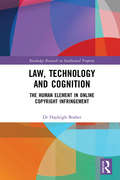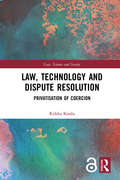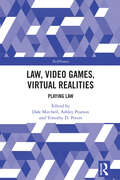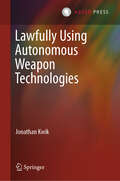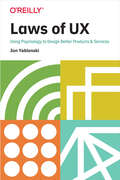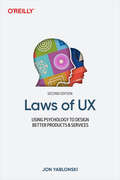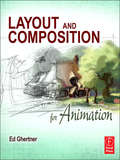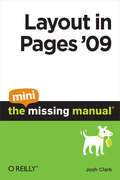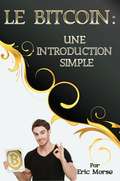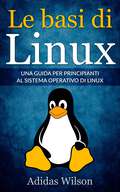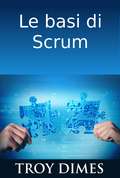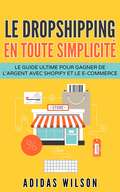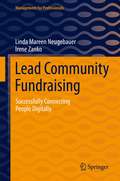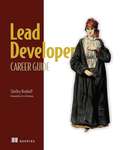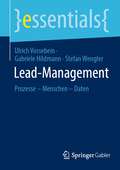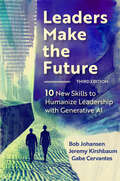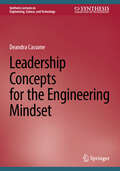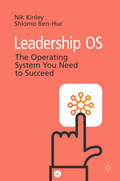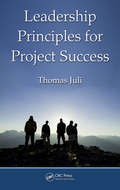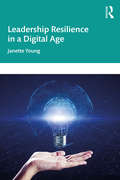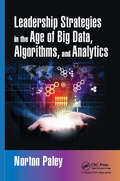- Table View
- List View
Law, Technology and Cognition: The Human Element in Online Copyright Infringement (Routledge Research in Intellectual Property)
by Hayleigh BosherThis book considers a new approach to online copyright infringement. Rather than looking at the subject within a purely technological context, it provides legal analysis from a human perspective. This book highlights that there are three key instances in which the capacity of a human mind intersects with the development of copyright regulation: (1) the development of copyright statutory law; (2) the interpretation of the copyright statutory law the judiciary; and (3) human interaction with new technology. Using a novel framework for constructing digital perspectives, the author, Dr Hayleigh Bosher, analyses the laws relating to online copyright infringement. She provides insights into why the law appears as it does, shedding light on the circumstances of how it came to pass and demonstrates a clear malfunction in the interpretation and application of copyright law to online activities that derives from the disconnect between the technological and the human perspectives. The book proposes putting the human element back into copyright analysis to enable the return of reason where it has been lost, and provide a clearer, more consistent and fair legal regulation of online copyright infringement. Law, Technology and Cognition: The Human Element in Online Copyright Infringement will be of interest to students, academics, researchers, as well as practitioners.
Law, Technology and Dispute Resolution: The Privatisation of Coercion (Law, Science and Society)
by Riikka KouluThe use of new information and communication technologies both inside the courts and in private online dispute resolution services is quickly changing everyday conflict management. However, the implications of the increasingly disruptive role of technology in dispute resolution remain largely undiscussed. In this book, assistant professor of law and digitalisation Riikka Koulu examines the multifaceted phenomenon of dispute resolution technology, focusing specifically on private enforcement, which modern technology enables on an unforeseen scale. The increase in private enforcement confounds legal structures and challenges the nation-state’s monopoly on violence. And, in this respect, the author argues that the technology-driven privatisation of enforcement – from direct enforcement of e-commerce platforms to self-executing smart contracts in the blockchain – brings the ethics of law’s coercive nature out into the open. This development constitutes a new, and dangerous, grey area of conflict management, which calls for transparency and public debate on the ethical implications of dispute resolution technology.
Law, Video Games, Virtual Realities: Playing Law (TechNomos)
by Ashley Pearson Dale Mitchell Timothy D. PetersThis edited volume explores the intersection between the coded realm of the video game and the equally codified space of law through an insightful collection of critical readings. Law is the ultimate multiplayer role-playing game. Involving a process of world-creation, law presents and codifies the parameters of licit and permitted behaviour, requiring individuals to engage their roles as a legal subject – the player-avatar of law – in order to be recognised, perform legal actions, activate rights or fulfil legal duties. Although traditional forms of law (copyright, property, privacy, freedom of expression) externally regulate the permissible content, form, dissemination, rights and behaviours of game designers, publishers, and players, this collection examines how players simulate, relate, and engage with environments and experiences shaped by legality in the realm of video game space. Featuring critical readings of video games as a means of understanding law and justice, this book contributes to the developing field of cultural legal studies, but will also be of interest to other legal theorists, socio-legal scholars, and games theorists.
Lawfully Using Autonomous Weapon Technologies
by Jonathan KwikThis monograph provides a practical and operational perspective to the question of how to lawfully employ autonomous weapon systems (AWS) from the point-of-view of the technology's end-users: field commanders. While there is international consensus that targeting rules such as proportionality and precautions must be respected when using AWS, there is legal and practical ambiguity as to how to translate this normative commitment into practice. How are commanders in the field, when guns are already blazing, expected to exercise command-and-control when ordering AWS-attacks, and ensure that their targeting obligations remain fulfilled? The book discusses how commanders can use existing targeting frameworks to ensure that their use of AWS remains in compliance with the rules governing the conduct of hostilities. It invites the reader to step into the shoes of the military commander with all the operational pressure and uncertainty inherent to this position, and explores amongst others: - How to maintain control of AWS throughout a targeting cycle; - How to make informed and reasoned deployment decisions by analysing information related to the technical parameters of the AWS, the characteristics of the operational environment, and enemy countermeasures; - Under which circumstances AWS may not be used under targeting rules, such as indiscriminate attack, proportionality and the duty to cancel/suspend; - What extra precautionary measures unique to AWS technology can and should be employed; - When it is militarily desirable to employ AWS over other alternatives; and - Under what circumstances criminal liability may be attributed for AWS-related harm. It offers both academic and practical outputs: new legal and doctrinal insights on the technology that is useful for future legal developments, and workable recommendations and efficient flowcharts that can be adopted by commanders, military organisations or policymakers to ensure IHL-compliant deployment of AWS. Dr. Jonathan Kwik is a researcher at the T.M.C. Asser Institute in The Hague specialised in artificial intelligence and targeting law, and is a member of the Board of Experts of the Asia-Pacific Journal of International Humanitarian Law.
Laws of UX: Using Psychology to Design Better Products & Services
by Jon YablonskiAn understanding of psychology—specifically the psychology behind how users behave and interact with digital interfaces—is perhaps the single most valuable nondesign skill a designer can have. The most elegant design can fail if it forces users to conform to the design rather than working within the “blueprint” of how humans perceive and process the world around them. This practical guide explains how you can apply key principles in psychology to build products and experiences that are more intuitive and human-centered. Author Jon Yablonski deconstructs familiar apps and experiences to provide clear examples of how UX designers can build experiences that adapt to how users perceive and process digital interfaces.You’ll learn:How aesthetically pleasing design creates positive responsesThe principles from psychology most useful for designersHow these psychology principles relate to UX heuristicsPredictive models including Fitts’s law, Jakob’s law, and Hick’s lawEthical implications of using psychology in designA framework for applying these principles
Laws of UX: Using Psychology to Design Better Products & Services
by Jon YablonskiAn understanding of psychology-specifically the psychology behind how users behave and interact with digital interfaces-is perhaps the single most valuable nondesign skill a designer can have. The most elegant design can fail if it forces users to conform to the design instead of working within the "blueprint" of how humans perceive and process the world around them.This practical guide explains how you can apply key principles of psychology to build products and experiences that are more human-centered and intuitive. Author Jon Yablonski deconstructs familiar apps and experiences to provide clear examples of how UX designers can build interfaces that adapt to how users perceive and process digital interfaces.You'll learn:How aesthetically pleasing design creates positive responsesThe principles of psychology most useful for designersHow these psychology principles relate to UX heuristicsPredictive models including Fitts's law, Jakob's law, and Hick's lawEthical implications of using psychology in designA practical framework for applying principles of psychology in your design processThis updated edition includes an even deeper connection to the underlying psychological concepts that govern the principles explored in the book, along with accompanying UX methods and techniques. Examples have been updated to ensure the deconstructed apps and experiences remain familiar and relevant.
Layout and Composition for Animation
by Ed GhertnerThis essential, hands-on guide is filled with examples of what a composition should look like and example of poorly designed layouts. Spot potential problems before they cost time and money, and adapt creative solutions for your own projects with this invaluable resource for beginner and intermediate artists. With Beauty and the Beast examples and Simpson character layouts, readers will learn how to develop character layout and background layout as well as strengthen composition styles with a creative toolset of trick shot examples and inspirational case studies. A companion website will include further technique based tools, finalized layout and composition examples and tutorials for further artistic skill development.
Layout in Pages '09: The Mini Missing Manual
by Josh ClarkPages '09 is more than just a word processor. It lets you create gorgeous page layouts for glossy newsletters, catalogs, brochures, greeting cards-you name it. This eBook makes you an instant expert in Pages' layout features. You'll learn how to arrange your text so it really flows and how to complement it with images, sounds, and movies.
Le Bitcoin : Une Introduction Simple
by Eric Morse Avinash MayaramComprendre les Bases du Bitcoin Le Bitcoin est une monnaie numérique révolutionnaire qui transforme l’argent tel que nous le connaissons, mais il peut être difficile à comprendre pour l’utilisateur moyen. Plus maintenant ! Ce livre élimine la complexité et enseigne les bases du Bitcoin dans un langage simple et facile à comprendre. Ce n’est pas un manuel. C’est un livre élémentaire non technique qui répond aux questions les plus courantes et importantes que posent les utilisateurs à propos du Bitcoin. Pas de jargon. Pas de bla-bla technologique. Aucune connaissance technique préalable n’est requise. Dans ce livre, vous trouverez les réponses à ces questions : Le Bitcoin, c’est quoi ? Qu’est-ce qui le rend spécial ? La Blockchain, c’est quoi ? Le minage, c’est quoi ? Qui contrôle le Bitcoin ? Le Bitcoin est-il sécurisé ? Le Bitcoin est-il anonyme ? Comment puis-je utiliser le Bitcoin de manière plus sûre ? Devrais-je investir en Bitcoin ? ...Et Bien Plus ! Et Vous n’aurez pas le sentiment d’apprendre une nouvelle langue ou d’obtenir une licence en informatique ! Prérequis : AUCUN ! Si vous avez déjà effectué un achat en ligne, vous avez déjà ce qu’il faut pour comprendre ce livre et apprendre les bases du Bitcoin.
Le Guide complet pour débrider le Stick Fire TV
by Rob StiegelmanComment installer Kodi sur les appareils Fire TV et Stick Fire d'Amazon Suite à l’installation de Kodi sur les appareils Fire TV, vous aurez accès à tout le contenu que vous voulez, comme des émissions de télévision, de la musique et des films. Voici ce que vous obtiendrez : Tout sur Kodi sur Stick Fire Installation de Kodi et débridage des appareils Stick Fire TV - Fonctionne sur tous les appareils Résolution des problèmes Profitez de l’accès à des films, de la musique, des émissions de télévision, des applications et plus encore ! --> Faites défiler jusqu’en haut de la page et cliquez sur Ajouter au panier pour acheter instantanément Avertissement : Cet auteur et / ou le(s) titulaire(s) des droits ne font aucune réclamation, promesse ou garantie sur l’exactitude, l’exhaustivité ou l’adéquation du contenu de ce livre, et décline expressément toute responsabilité pour les erreurs et les omissions dans le contenu. Ce produit est destiné à un usage de référence uniquement.
Le Kindle Fire HD 8 & 10 Guide 2019 Mise À Jour: Moyens faciles et rapides pour comprendre votre Kindle Fire HD et solution aux problèmes courants
by Smith AnthonyTHE KINDLE FIRE HD 8 & 10 GUIDE 2019 MISE À JOUR Les guides de ce manuel sont principalement destinés aux utilisateurs de KINDLE Fire qui n'ont rien appris de nouveau sur la façon de maximiser votre Kindle Fire HD 8 et 10. Vous obtiendrez de nouveaux trucs et astuces cachés qui vous permettront de maîtriser votre appareil. Ce manuel vous guidera pas à pas vers les fonctions avancées des processus Kindle Fire HD 8 et 10 sur la configuration initiale, les fonctions de base, les paramètres avancés et bien plus encore. D'autres informations importantes que vous obtiendrez de ce livre incluent ; Raison du Kindle Fire HD 8 et 10 Comment mettre en place Kindle feu HD 8 et 10 La meilleure façon de charger votre Kindle Fire HD 8 et 10 À L'AIDE D'UN ORDINATEUR À L'AIDE D'UN ADAPTATEUR MURAL Navigation sur l'écran de votre terminal Magasiner sur Amazon Fonctionnalité des trois boutons de l'écran de votre appareil Magasiner sur Amazon COMMENT FAIRE UN MIROIR DE VOTRE FEU ALLUMÉ HD À VOTRE TÉLÉVISEUR À L'AIDE D'UN BÂTON DE FEU Comment accélérer votre feu lent HD Mon feu allumé ne s'allume pas. Votre feu allumé HD ne se charge pas Mon feu allumé n'a pas de son Comment maximiser Alexa sur un feu HD Comprimé Possibilité de pouvoir changer la couleur du clavier Possibilité de changer le texte à la voix de la parole Arrêt automatique pour le Wi-Fi Possibilité d'avoir des émojis ou des émoticônes sur le clavier Possibilité de changer le comportement d'autocorrection Comment retrouver votre tablette perdue à l'aide du GPS Fonds d'écran Capacité de refléter votre feu de Kindle Ne tergiversez pas davantage, naviguez vers le haut et cliquez sur le bouton "ACHETER" pour obtenir ce manuel afin de maîtriser votre appareil et devenir un expert en K
Le Marketing par Média sociaux
by Adidas WilsonLe guide ultime de l’utilisateur pour Facebook, Instagram, YouTube, le Blog, Twitter, LinkedIn, TikTok, Pinterest Qu’est-ce qu’un engagement sur les médias sociaux ? Il s’agit du nombre de partages, de likes et de commentaires. Un bon suivi c’est bien, mais une audience engagée c’est encore mieux. La qualité prime sur la quantité. Qu’est-ce qu’un engagement sur les médias sociaux ? Il s’agit du nombre de partages, de likes et de commentaires. Un bon suivi c’est bien, mais une audience engagée c’est encore mieux. La qualité prime sur la quantité. Il y a certain métriques utilisés pour mesurer l’engagement des medias sociaux. Elles comprennent : l’usage des hashtags de la marque. Les mentions. Les taux de clics. La croissance de l’audience et du nombre d’abonnés. Les Likes. Les commentaires. Les retweets et les partages. Vos abonnés peuvent commencer à s’engager naturellement avec votre contenu. Mais la plupart du temps, vous avez besoin de les encourager un peu. Evaluez votre engagement : vérifiez combien d’abonnés vous avez, la moyenne des partages et des commentaires que vous avez sur chaque publication et tout autre chiffre pertinent. Assurez-vous de continuer à monitorer ces chiffres. Choisissez votre stratégie : chaque société va dépendre de vos objectifs. Ça pourrait éduquer votre audience, collecter les feedbacks, changer la perception du public, etc. comprendre votre audience : ce n’est pas facile d’engager les gens que vous ne connaissez pas.
Le basi di Linux: Una guida per principianti al sistema operativo di Linux
by Adidas WilsonLinux è l'unico sistema operativo per endpoint che sta crescendo a livello globale. Come ha detto una persona, "Linux è il Nikola Tesla dell'informatica". Questo sistema operativo è utilizzato in una miriade di dispositivi, tra cui smartphone, videoregistratori digitali, televisori, sistemi di intrattenimento delle compagnie aeree, segnaletica digitale, sistemi di controllo delle automobili, switch, router, desktop e molti altri. Il dibattito sui sistemi operativi Microsoft Windows e Linux non finirà presto. Tuttavia, è evidente che Linux sta vincendo. Se avete difficoltà a crederlo, considerate l'influenza di Linux sui dispositivi Android e Apple basati su UNIX. L'unico motivo per cui Windows è ancora diffuso è la sua influenza su molte applicazioni principali. Questa situazione sta per cambiare e Linux è, senza dubbio, il futuro. Microsoft è stato il re dell'End User Computing (EUC) per circa 30 anni. Tuttavia, alcuni fattori, come i problemi di sicurezza, stanno spingendo l'EUC verso il data center. Per questo motivo, c'è il desiderio di ridurre i costi e i rischi legati al mantenimento di Windows sul bordo. Il sistema operativo Linux offre la soluzione perfetta. Linux è stratificato e leggero, il che gli consente di funzionare molto bene su molti tipi di dispositivi. Inoltre, offre velocità e reattività elevate. Poiché Linux presenta numerosi vantaggi intrinseci, è preferito per le applicazioni endpoint.
Le basi di Scrum
by Troy Dimes Stefano SpeltaCreare software che offre più valore Di idee se ne trovano a iosa. Un sacco di gente sembra pensare che la maggior parte del processo di sviluppo del software consista nella semplice creazione di un'applicazione, vagamente legata ad un concetto, che la gente potrebbe desiderare. Probabilmente avrete sentito moltissima gente dire cose come: "Ho questa idea per un'app che raggiungerà sicuramente un milione di download!" solo per trovare poi la loro applicazione dispersa in un oceano di applicazioni simili. La creazione di software eccellente ed il suo rilascio nei tempi corretti richiedono uno schema di implementazione abbastanza sistematico ma non eccessivamente rigido. Qualità e tempi devono convivere. Se si rilascia un software che è pieno di bachi o che ha una user experience mediocre non ci si potrà di certo attendere un'altra commessa da parte del cliente. Molti programmatori temono questo esito e, di conseguenza, impiegano troppo tempo per sviluppare i programmi. Voi avete una quantità limitata di tempo per sviluppare un software, soprattutto quando dovete rispettare una data di scadenza, autoimposta o meno. Dovrete fare in modo che il software creato sia almeno decente ma, ancora più importante, rilasciato in modo tempestivo. Come si fa a bilanciare la qualità con il tempo? Questo libro spazia tra questi importantissimi argomenti. Dopo aver letto Le basi di Scrum conoscerete i significati dei ruoli di Scrum, degli Sprint, degli artefatti di Scrum e di molto altro. Ecco cosa imparerete leggendo Le basi di Scrum: *Cos'è il metodo Waterfall e perché non dovreste usarlo per i vostri progetti software *Che cosa è Scrum, da dove viene, perché dovreste usarlo e come potete metterlo in pratica nella vostra organizzazione oggi *Quale è la differenza tra Scrum e Agile Software Development? *I vari ruoli di Scrum, tra cui il Product Owner, lo Scrum Master ed i memb
Le dropshipping en toute simplicité: Le guide ultime pour gagner de l'argent avec Shopify et le e-commerce
by Adidas WilsonLe Dropshipping est une méthode de vente au détail où les boutiques ne stockent pas réellement leurs produits. Lorsqu’un client achète un produit, le vendeur l'achète à une autre partie et l'expédie directement au client. Le commerçant ne manipule ni ne voit le produit. Le dropshipping diffère du modèle de vente au détail conventionnel en ce sens que, dans ce cas, le vendeur ne possède pas de stock. Il ou elle achète une commande à un tiers. Comme tout le reste, le modèle du dropshipping présente des inconvénients et des avantages. Vous avez besoin de moins de capital : c'est sans doute le plus grand avantage. Vous n'avez pas besoin de milliers de dollars pour lancer une boutique de e-commerce. Les détaillants conventionnels doivent disposer d'un capital énorme pour constituer leur stock. Dans le cas du dropshipping, vous n'achetez un produit que lorsqu'un client a passé une commande et effectué le paiement. Un investissement initial dans le stock n'est pas nécessaire. Facile à démarrer : une entreprise de e-commerce est beaucoup plus facile à gérer lorsque vous ne manipulez pas de produits physiques. Vous n'aurez pas à vous soucier d'un entrepôt, de l'emballage et de l'expédition, du suivi des stocks, de la gestion des retours, etc. Faibles frais généraux : puisque vous n'aurez pas à vous occuper d'un entrepôt ou à acheter des stocks, attendez-vous à de faibles frais généraux. Beaucoup de personnes gèrent une entreprise de dropshipping depuis leur bureau à domicile avec leur ordinateur portable et ne dépensent qu'environ 100 $ par mois. Les dépenses peuvent augmenter au fur et à mesure que votre entreprise se développe, mais elles resteront faibles. Emplacement flexible : si vous avez une connexion Internet, vous pouvez gérer votre entreprise de dropshipping de n'importe où.
Le guide ultime de Windows 10: Conseils et astuces pour gagner du temps et utiliser Windows 10 comme un pro
by Jon AlbertUn guide détaillé pour connaître les trucs et astuces de windows 10. Ce guide vous aidera à utiliser Windows 10 comme un pro, des trucs et astuces pour gagner du temps. Ce livre vous apprendra à : - Configurer l'explorateur Windows - Supprimer 'Bing' de microsoft edge - Configurer cortana - Prendre le contrôle de la mise à jour de Windows 10 - Se débarrasser de l'écran de connexion de Windows 10 - Désactiver le flash dans Edge Si vous voulez utiliser Windows 10 comme un Pro, alors ce livre est pour vous. --> Faites défiler jusqu'en haut de la page et cliquez sur ajouter au panier pour acheter instantanément Avis de non-responsabilité : Cet auteur et ou le(s) propriétaire(s) des droits ne font aucune réclamation, promesse ou garantie quant à l'exactitude, l'exhaustivité ou l'adéquation du contenu de ce livre, et rejette expressément toute responsabilité en cas d'erreur ou d'omission dans le contenu de celui-ci. Ce produit est destiné à un usage de référence uniquement.
Lead Community Fundraising: Successfully Connecting People Digitally (Management for Professionals)
by Linda Mareen Neugebauer Irene ZankoThe world is changing, and so are our donors. In the future, it will become even more important for organizations to find leads, supporters and new donors online - because digitization is a bottleneck in fundraising.This book highlights universal fundraising opportunities. It explains the fundamentals of lead community fundraising and why, especially in digital times, it is important to start with the people - the community. The main topic of the book is the current state of digital fundraising, which is becoming more and more important. More than 45 examples from international fundraising practices provide a valuable foundation for all practitioners in this field.
Lead Developer Career Guide
by Shelley BenhoffLearn the skills you need to be a lead developer, with expert advice on mentoring teams, handling clients and project managers, and keeping your head in emergencies.The Lead Developer Career Guide teaches you how to transition from an individual contributor to a thriving lead developer. It's packed with insider tips, tricks, and strategies drawn from author Shelley Benhoff's 25-year career in technology, providing vital insights for navigating the unique challenges and expectations of the lead developer role. This one-of-a-kind book demonstrates how critical thinking and communication skills can elevate your career. In the Lead Developer Career Guide you'll discover: • The key responsibilities of a lead developer • Techniques for writing effective technical documentation • Strategies for improving development processes • Best practices for communicating with non-technical clients • Methods for mentoring and inspiring a team • Approaches for delivering negative feedback constructively The Lead Developer Career Guide is filled with interviews and real-world case studies from industry professionals and esteemed tech experts. You'll learn how to become the public face for your development team, gathering feedback from your coworkers and communicating with clients and stakeholders. Plus, you'll find proven techniques to reliably calculate project estimates, plan a project from scratch, and mentor junior developers and peers alike. Foreword by Steve Buchanan. About the technology To be a successful Lead Developer you&’ll need more than just technical expertise. You&’ll be responsible for everything from facilitating architectural decisions that satisfy all stakeholders to mentoring your fellow developers. And you&’ll be on the hook for delivering great software on time and under budget. Are you ready for the challenge? This book will help get you there! About the book The Lead Developer Career Guide provides the techniques and wisdom you need to transition from individual contributor to lead developer. You&’ll learn how to collaborate effectively with executive leadership and project managers, present elegant solutions to clients, and think quickly in those inevitable emergencies. When all eyes are on you, this book will ensure you know exactly what to do. What's inside • Improving development processes • Mentoring and inspiring a team • Delivering negative feedback About the reader For aspiring lead developers. About the author Shelley Benhoff has over twenty-five years of experience in tech as a business owner, author, and speaker. The technical editor on this book was Stephen Mizell. Table of Contents 1 What is a lead developer? 2 Lead developer career trajectory 3 Learning lead developer skills 4 Learning any developer skill 5 Writing technical documentation 6 Optimizing the development process 7 Working with project teams 8 Speaking with clients 9 Being a mentor 10 Taking the lead 11 Leading with emotional intelligence 12 Being a successful lead developer
Lead-Management: Prozesse – Menschen – Daten (essentials)
by Ulrich Vossebein Gabriele Hildmann Stefan WenglerLead-Management ist eine der großen Herausforderungen im Vertrieb, da die Neukundengewinnung immer bedeutsamer wird. Dieses essential erläutert, wie durch den parallelen Ausbau der drei Basisdimensionen: Prozesse, Menschen und Daten Lead-Exzellenz erreicht werden kann. Hierzu sind zunächst die Rahmenbedingungen zu analysieren und zu bewerten. Anschließend müssen die Prozesse in eine Prozesslandkarte eingebunden, die Kompetenzprofile den neuen Anforderungen angepasst und die Datenbasis vervollständigt werden. Eine umfangreiche Checkliste zeigt auf, wie Unternehmen bei der Einführung oder Überarbeitung ihres bereits existierenden Lead-Managements sinnvollerweise vorgehen sollten.
Leaders Make the Future, Third Edition: Ten New Skills to Humanize Leadership with Generative AI
by Bob Johansen Jeremy Kirshbaum Gabe CervantesIn a world of chaos, how can generative AI help leaders lead?Over the next decade, all leaders will be augmented with some form of generative artificial intelligence, or GenAI. For the best leaders, this will mean dramatic improvement. For mediocre leaders, this will mean persistent confusion, distraction, and pretense. With futureback thinking—looking ten years ahead, then planning backward from future to next to now—this third edition of Leaders Make the Future shows how people can improve their leadership skills while expanding their human perspective.Now 75 percent revised and expanded with resources from the Institute for the Future, this new edition is organized around ten future leadership skills:Augmented futureback curiosityAugmented clarityAugmented dilemma flippingAugmented bio-engagingAugmented immersive learningAugmented depolarizingAugmented commons creatingAugmented smart mob swarmingAugmented strength with humilityHuman calmingAI-augmented leadership will be key for any organization to tackle the uncertainty of the future. And by incorporating practical methodologies, ethical guidelines, and innovative leadership practices, this book will help leaders develop their clarity and moderate their certainty.
Leadership Concepts for the Engineering Mindset (Synthesis Lectures on Engineering, Science, and Technology)
by Deandra CassoneThe book is intended to focus the engineer or technically minded individual on key aspects of their organization and how they can leverage their position to make a positive impact. The author explains why it is critical that the technically minded individual is aware of their corporate environment and how they and their organization fit within the organizational structure. Technical knowledge is just one component of success for engineers. The book provides readers with the tools to understand where they fit in with their organizations and what they can do to support corporate objectives. This book will address topics including gaining a big picture of an organization, defining what a specific organization does, understanding goals and objectives to align management strategies, budgeting, role in the supply chain, engineering career paths, and the importance of innovation.
Leadership OS: The Operating System You Need to Succeed
by Shlomo Ben-Hur Nik KinleyBased on years of original research, this book controversially counters almost every existing leadership model and approach.It shows how as leaders rise to senior levels, their roles become less about doing things that directly drive results and more about directing and supporting others to achieve objectives. Using case studies and research insights the authors reveal how leadership success is thus not so much about having the right core capabilities, but about creating the right environment.Using the analogy of a smartphone operating system (OS), the book presents a new way of thinking about leadership. The authors provide a clear and practical framework to follow and show how your leadership OS becomes the impact you have, the imprint you make and the foundation of your legacy as a leader.After reading it, you will learn:· How to diagnose the impact you have as a leader and understand the OS you create· How famous business and societal leaders have created effective – and sometimes ineffective – OSs· How to optimise your OS to produce the best results· How to get people working together effectively, and be a high-performing leaderProviding you with practical and easy to follow advice, this book will show you how leadership success is not about having the core capabilities, but about creating the right operating systems for your organisation.
Leadership Principles for Project Success
by Thomas JuliThis book is about project success and the secret to achieving this success, effective project leadership. Filled with samples, templates, and guidelines, it covers the five principles of effective project leadership: building vision, nurturing collaboration, promoting performance, cultivating learning, and ensuring results. Using nontechnical lang
Leadership Resilience in a Digital Age
by Janette YoungThe book focusses on the challenges faced in the digital age, and the increasing demands for continuous change in an inter-connected digital world. The book presents stories about how leaders have faced significant challenges and pressure, and how they have used these experiences as catalysts to transform, flourish, and develop personal resilience. The book explores the digital journey, ethical issues, teamwork, styles of leadership, agile, collaboration, trust, culture, psychological safety, self-awareness, vulnerability, conversation, positivity, emotional intelligence, creativity, inner knowing and the dark side of leadership. Drawing on the experiences of leaders in the creative, digital and technology sectors in the UK, and using their voice throughout, has resulted in proposing several internal and external strategic solutions to help the reader become more personally resilient. The book explores the impact of continuous change within a digital age, presenting the facets necessary to become a Digital Sage in an increasingly chaotic world. With a focus on creativity, innovation and mind and body awareness the leader as a Digital Sage arises to encourage resilience in a digital age. The book does not assume prior knowledge of the field of resilience and is ideal for executive education courses, and for leaders and managers seeking personal and professional transformation.
Leadership Strategies in the Age of Big Data, Algorithms, and Analytics
by Norton PaleyHarnessing the power of technology is one of the key measures of effective leadership. Leadership Strategies in the Age of Big Data, Algorithms, and Analytics will help leaders think and act like strategists to maintain a leading-edge competitive advantage. Written by a leading expert in the field, this book provides new insights on how to successfully transition companies by aligning an organization’s culture to accept the benefits of digital technology. The author emphasizes the importance of creating a team spirit with employees to embrace the digital age and develop strategic business plans that pinpoint new markets for growth, strengthen customer relationships, and develop competitive strategies. Understanding how to deal with inconsistencies when facts generated by data analytics disagree with your own experience, intuition, and knowledge of the competitive situation is key to successful leadership.
